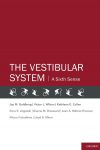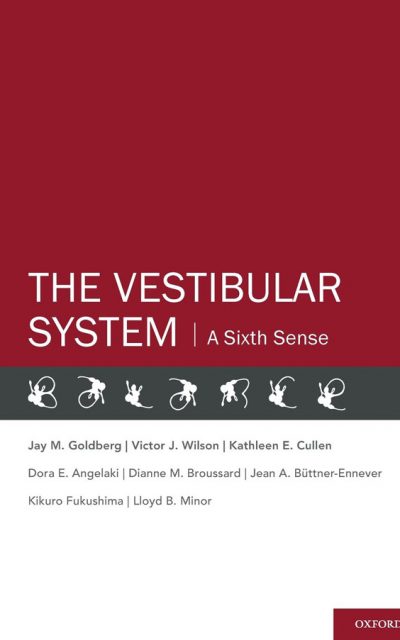 Authors: Jay M. Goldberg, Victor J. Wilson, Kathleen E. Cullen, Dora E. Angelaki, Diane M. Broussard, Jean A. Buttner-Ennever, Kikiro Fukushima, and Lloyd B. Minor
Authors: Jay M. Goldberg, Victor J. Wilson, Kathleen E. Cullen, Dora E. Angelaki, Diane M. Broussard, Jean A. Buttner-Ennever, Kikiro Fukushima, and Lloyd B. Minor
Publisher: Oxford University Press – 541 pages
Book Review by: Nano Khilnani
The vestibular system in the human body is somewhat related to the five senses of hearing, sight, smell, taste, and touch, but is distinct from it. The vestibular system relates to, or affects the perception of body position and movement. Located in our inner ear, it is sometimes called the “human balancing system.” But it does more than that.
Not only preventing imbalance, but also helping avoid dizziness, vertigo and the feelings of discomfort, nausea, motion sickness and other effects are functions of our vestibular system.
This book is one of those rare ones on the vestibular system that takes a broad and deep look into it. Its coverage is not only extensive but intensive as well, as revealed by its contents:
Part I. Introduction
- The Vestibular System in Everyday Life
Part II. Peripheral Vestibular System
- Structure of the Vestibular Labyrinth
- Hair Cell Transduction
- Physiology of the Vestibular Organs
- The Efferent Vestibular System
Part III. Central Vestibular System
- Neuroanatomy of the Central Vestibular Pathways
- Synaptic Mechanisms in the Vestibular Nuclei
Part IV. Vestibulo-Ocular and Vestibulospinal Mechanisms
- An Oculomotor Tutorial
- Vestibulo-Ocular Reflexes
- The Vestibulospinal System and Postural Control
Part V. Signal Processing in Alert Animals
- Signal Processing in Vestibular Nuclei (VN) of Alert Animals During Natural Behaviors
- The Cerebellum and the Vestibular System
Part VI. Functional Considerations
- Learning and Compensation in the Vestibular System
- Cortical Representations of Vestibular Information
- Reference Frames for the Coding of Vestibular Signals
Part VII. Clinical Considerations
- Clinical Manifestations of Peripheral Vestibular Dysfunction
The authors point out that while Aristotle wrote about our five senses, it was only until the middle of the nineteenth century that the vestibular system was viewed upon as a distinct entity.
One of the reasons why the vestibular system was not written about much and pretty much neglected in early medical history is that our outer ears were part of our inner hearing system. And so the vestibular system – with distinct functions of giving us our sense of balance, position and movement – was just assumed to be part of our total hearing system.
We urge readers of this review to take a look at the diagrams in this book of the inner ear and other illustrations in it to get a grasp of the structure and functions of the vestibular system. In chapter 1 you can read an overview of the vestibular system in humans and animals and some of its aspects and functions, such as:
- Visual Acuity and the Vestibulo-Ocular Reflex
- Air-Righting Reflex in the Cat
- Post-Rotational Reactions
- Positional Alcohol Nystagmus
- Motion Sickness
- Vection Illusions
- The Subjective Visual Vertical
- Adaptive Plasticity
- Path Finding and Spatial Orientation
- Postural Control
This book not only provides a basic overview, structure, and functions of the vestibular system in our everyday lives, but also offers recent research on topics such as the control of gaze and posture, and neural correlates of self-motion. It is an excellent book on the subject.
Authors:
Jay M. Goldberg, PhD is with the Department of Neurobiology, Pharmacology and Physiology at the University of Chicago in Chicago, Illinois.
Victor J. Wilson, PhD is with the Laboratory of Neurophysiology of Rockefeller University in New York, New York.
Kathleen E. Cullen, PhD is with the Department of Physiology at McGill University in Montreal, Canada.
Dora E. Angelaki, PhD is with the Department of Anatomy and Neurobiology at Washington University School of Medicine in St. Louis, Missouri.
Jean A. Buttner-Ennever, PhD is with the Institute of Anatomy 1 at Ludwig-Maximilians University of Munich in Munich, Germany.
Lloyd B. Minor, MD is with the Department of Otolaryngology – Head & Neck Surgery, Neuroscience and Biomedical Engineering at Johns Hopkins University in Baltimore, Maryland.
Dianne M. Broussard, PhD is with the Division of Cellular and Molecular Biology at Toronto Western Hospital in Toronto, Canada.
Kikuro Fukushima, PhD, MD is with the Department of Physiology at Hokkaido University School of Medicine in Kitaku, Sapporo, Japan.







